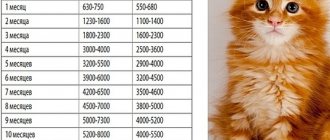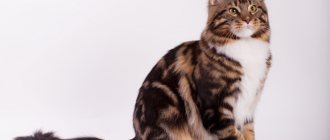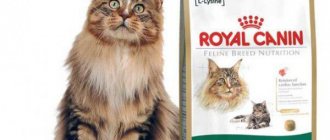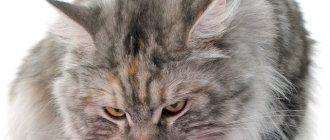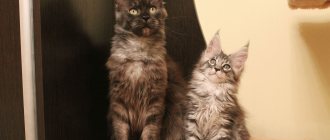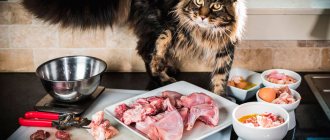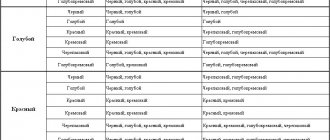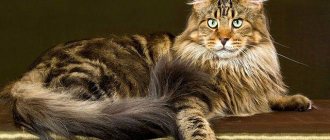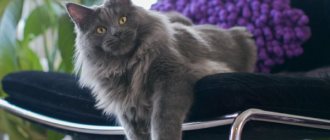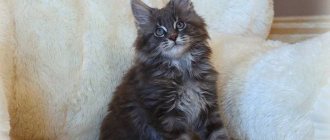Mating of Maine Coons is a very important and responsible period that begins when the grown-up Coon declares his readiness to continue the family - the cats begin to mark the room, the cats meow, rub against vertical objects and roll around on the floor. Maine Coons are ready for mating after the third heat - usually this happens between 10 months and one and a half years. It happens that the first heat occurs earlier - at the age of 7-8 months. The cat reaches its prime at one and a half years, but it is ready to breed from about 8 months.
What do novice owners need to know?
It is not advisable to allow individuals older than two years to mate. Due to their lack of experience, they may develop behavioral problems.
It is best to contact a felinological club, where they will find a “partner” for your pet. Or you can contact the owner of the Maine Coon after meeting him at the exhibition.
Extra forethought in such situations is only welcome, since the intended candidate may well be busy at the right time.
Beginning owners need to know a few nuances before breeding Maine Coons/Yandex Collections
The selected animal must have participated in exhibitions and be rated at least “very good”. Otherwise, the kittens will not be purebred, even if both parents are coons.
Before mating cats and Maine Coon cats, the animal must be vaccinated against a number of different diseases.
Documents are not only whiskers, paws and tail
In order for everything connected with the birth of kittens to go well, mutual understanding is necessary not only between the future coon parents, but also between their owners. Mating of Maine Coons is usually documented. It is necessary to draw up a mating agreement that specifies the obligations of both parties. While the cat is in the cat’s territory, the owner of the Maine Coon bears full responsibility for it. The contract specifies the names of the Maine Coons, the owners of the animals and their addresses. The document is signed by both parties. It contains information about the health status of Maine Coons, mating conditions, fees for mating, and also discusses the procedure for a failed mating. The contract specifies the costs of keeping kittens and the procedure for their registration and documentation.
Payment
Usually, for mating, the cat owner receives a fixed amount or one kitten from the litter, but he has the right to know all the information about the kittens born as a result of mating. When only one kitten is born, the owner of the coon cat receives half the price of the kitten upon sale.
If mutually desired, animal owners can stipulate a different payment method in the contract. A mating agreement helps to avoid conflict situations that often arise when dividing offspring between owners of parent coons.
Owners of breeding Maine Coons often keep records where they note not only the mating dates and names of the animals, but also the color and behavioral characteristics of the cats. Often this information is indicated in the female's veterinary passport. This is necessary for the optimal selection of pairs from which healthy offspring are born with a sought-after color and well-defined breed characteristics.
Preparation
The nervous system of cats is also not made of iron, so it is better to bring the female Maine Coon to a potential partner in advance so that she becomes familiar with the situation. It's better to do this in a couple of days. It is also important that future parents get to know each other in advance.
Despite the fairly fast mating process in cats, it is recommended that Maine Coons be given plenty of time for mating, since certain difficulties with communication may arise. So, this can take from several hours to a day.
You need to bring the cat to the cat's owner's house on the second day of estrus. You should also take all the female’s things: food, dishes, tray. It is important to take care of the documents and take a copy of the pedigree with you.
How successful the process will be can be determined by the cat’s behavior. If he does not show any interest in a potential partner, the mating will not take place.
Advice! Before mating, trim your pets' nails to prevent them from scratching themselves during interaction.
For an experienced female, you can select any male, and vice versa. It should be remembered that after the first meeting the cat does not always manage to become pregnant.
If the result was not achieved, after some time you need to organize another date with the same male.
Mating Maine Coons can take from several hours to a day/Yandex Collections
Full coloring
Solid colors are common. They are usually called solid. Then the tabby is suppressed to one degree or another. That is, the drawing may be completely invisible. This mainly applies to those cats whose main color is black. The darker, the less expressive the stripes or spots. Tabby is most visible in red cats. Europeans have another name for the term “solid” and it sounds like “self”.
The manifestation of patterns in coons can be seen using the example of wild animals. On the dark fur of a panther it is almost invisible. However, in bright light, the outlines of the spots on the body appear. Despite the black color, the tabby is not completely suppressed.
The Coon breed began to give birth to solids due to selection work. It is believed that the emerging tabby in some cats is a “shadow” phenomenon. In white kittens, at a very early age, the pattern is slightly noticeable on the head. Over time, it disappears completely.
Solid colors come in the following colors and shades:
The last point is of particular interest. The genetics of cats suggests a lot of options for pigment distribution. Solid or monochromatic hair in the root zone is gray in color of varying intensity.
Optimal environment for mating
Typically, a closed room with a minimum amount of furniture is chosen for mating. This is done so that the cat, in case of problems with communication, can hide from its boyfriend, but remain in his field of vision.
A heavily crowded room will most likely slow down the process, which in such conditions may not take place at all - the animals will simply get tired and change their plans.
The process can take place in different ways. Some Maine Coons are quite loud, while others are so quiet that it may seem like they are not doing anything at all.
Animal behavior also varies. Some behave quite aggressively, while others, on the contrary, are affectionate in communication.
For breeding Maine Coons, choose an enclosed space / Yandex Collections
Usually human intervention is not required, but there are times when it is necessary. For example, if a cat has taken a position that is uncomfortable for the male, she needs to be held in the right position.
The most popular Maine Coon colors
Maine Coons have two basic colors – red and black. The remaining colors appeared as variations of the original color scheme. White is not a base shade, but indicates that there is simply no pigmentation.
Cats of this breed have a large range of colors classified, which allows you to specifically and briefly describe the appearance of the animal.
Red marble
The pattern on the fur of ginger cats is spiral-shaped, and the pattern is several tones lighter than the main hair coat.
Marbleds are classified as the classic tabby variety. Red marble
Black marble
The pattern is located in the same way as in red marble. The only difference is that the pattern is arranged in black patterns on brown wool.
Solid
Solid is characterized by a uniform coat color. Pigmentation is obtained by recessing the gene responsible for the tabby color. As a result, makecoons have a chic, monochromatic coat with subtle stripes, which can be seen in representatives with blue or beige coat.
The following types of solid are distinguished:
- Black
- White
- Red
- Blue
- Beige
Solid
Smoky
Smoke coloring is characterized by uneven pigmentation of the hair.
The root area is white, or several shades lighter than the upper part of the hair. As the cat moves, the light tone becomes more noticeable, highlighting the beauty of the pet.
- Blue
- Black
- Red
- Tortoiseshell
Smoky
In addition to these colors, there are divisions according to the length of colored hair:
- Chinchilla – 1/8 of the hair is dyed
- Shaded - 1/4 of the hair is colored
- Smoky – 1/2 part of the hairline.
Only the top part of the hair is brightly pigmented. The beauty of the smoky color is conveyed during any movements of the Maine Coon.
Tortoiseshell
All over the cat's body there are randomly located spots of red, black, white and brown.
Tortoiseshell color is more common in females. This is due to the attachment of the tortoiseshell color gene to the X chromosome. Tortoiseshell
Tabby
Maine Coon striped color. With this coloring, each hair is unevenly colored in different colors and shades, creating an intricate striped pattern on the pet’s fur. Common Maine Coon color scheme.
It is assumed that “tabby” is characteristic of wild cats and is the original coloring of the first domesticated purrs.
- Brindle – stripes are located vertically throughout the cat’s body.
- Classic – marble colors.
- Spotted - intermittent stripes on the coat, forming longitudinal or thin oval spots.
- Ticked - stripes are present only on the face. Among Maine Coons it is considered a rarity and is a defect, since it is not recognized as a breed.
Tabby
Silver
Silver color refers to marble colors. The Maine Coon's light gray coat is coated with a marbled spiral pattern with black pigment.
White
Refers to solids.
A rare color for Maine Coons. Pure white cats without patterns or spots. Animals of a given color do not exhibit any pattern arrangement, regardless of viewing angle.
White
Calico
White cats with bright red and black spots on the body. The spots are outlined and stand out against a white background.
A distinctive feature of calicos from turtles is that when calicos are painted, the spots are located on a white background, while in turtles they are on a black background.
Calico
Color designation
The letter part is the definition of the base color on the animal’s coat. Placed at the beginning of the encoding.
| W | white |
| N | black |
| D | red |
| A | blue |
| E | cream |
| F | tortoiseshell |
| G | blue-cream tortoiseshell. Appeared as a result of discoloration of the classic tortoiseshell color. |
The digital part is the designation of the pattern on the Maine Coon's coat. The arrangement of white spots begins from scratch:
| 01 | predominantly white with colored spots on the head, tail and shoulder area. |
| 02 | white with spots on head, tail, shoulders and spine. |
| 03 | 1/2 wool is white. |
| 09 | white spots on the limbs or chest. |
Tabby drawings:
| 22 | brindle |
| 23 | marble or classic |
| 24 | spotted |
| 25 | ticked |
Maine Coon eye color is rarely marked, since breed standards allow for free coloring of the iris.
Knowing the markings of colors and colors according to the table allows you to choose a Maine Coon kitten without looking at its photographs. At the same time, the future owner of the animal will know what color the animal will come to him, which makes it easier to choose a pet outside of his locality.
Signs of a successful mating
It is better to perform mating in the evening, when there is no noise or screaming in the room, and nothing distracts the animals. In this state, they do not experience stress, which allows them to fully concentrate on the process.
You can determine how successful the mating was by the behavior of the cats. If the cat stops behaving aggressively towards its partner, but shows signs of affection, this means that everything went well.
Maine Coons can mate more than ten times per day. It is better not to allow this, since kittens of different ages may be born.
A cat usually stays with its partner for up to four days. If the male no longer shows interest in the female, she can be taken home - the mating has taken place.
It is better to prevent communication between cats that lasts less than one day - this can disturb the psyche of the animals.
Signs of pregnancy in a cat may appear 20 to 30 days after mating. If there are none, the mating process is repeated.
White spots
Bright white markings are in addition to the main color. The Maine Coon's spots are distributed depending on many factors. In documents of origin it is customary to write down as follows:
Van – a large amount of white, colored color on the head and tail (van); White buttons are small spots (buttons); Harlequin – large colored spots against a white background (harlequin); Locket – a white spot on the chest of a Maine Coon (locket); Bicolor – white and color 50/50 (bi-color); Gloves - the ends of the paws are white (mitted).
If a Coon has white markings on his paws and chest, then he has a tuxedo. There is no official definition of this, but many people use it. Spots can also be found on the head of a Maine Coon.
